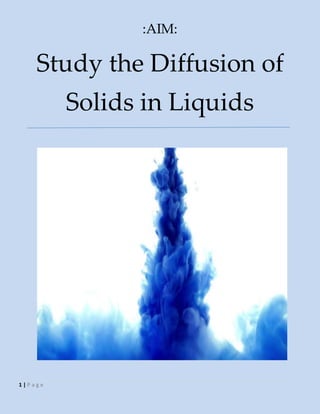
Chem project
- 1. 1 | P a g e :AIM: Study the Diffusion of Solids in Liquids
- 2. 2 | P a g e INTRODUCTION Diffusion is the process of a substance spreading out to evenly fill its container or environment. In a solution, a concentrated solute diffuses to spread evenly in its solvent. In air, gas molecules diffuse to mix thoroughly. Substances diffuse from areas of high concentration to low concentration. Diffusion takes place very rapidly in case of gases, to a lesser extent in case of liquids, and not at all in the case of solids. However, diffusion of solids in liquids does take place, albeit at a very slow rate. If a solid is kept in contact with excess of solvent in which it is soluble, some portion of the solid gets dissolved. This process is known as dissolution of a solid in liquid, and it takes place due to the diffusion of solid particles into liquid medium. Molecules of solute are in constant random motion due to the collision between molecules of solute and that of the solvent. It is this physical interaction between solute-solvent particles that leads to diffusion.
- 3. 3 | P a g e Objective To demonstrate that rate of diffusion depends upon the following factors: Temperature: As temperature increases, the kinetic energy of the particles increases. Thus, the speed of particles also increases, which in turn increases the rate of diffusion. Size of the particle: As the size of particle increases, rate of diffusion decreases. This is because the particles become less mobile in the solvent. Mass of the particle: As the mass of the particle increases, the rate of diffusion decreases; as the particle becomes less mobile.
- 4. 4 | P a g e Experiment 1 Aim To study diffusion when copper sulphate is brought in contact with water (liquid). Requirements Copper sulphate (CuSO4) crystals 100 mL beaker Procedure Take about two grams of copper sulphate crystals in 100 mL beaker.
- 5. 5 | P a g e Add about 50 mL of water and allow it to stand for few minutes. Note the development of blue color in water. Allow to stand further till it is observed that all copper sulphate disappears. Note the blue color change in water. Conclusion When solids such as copper sulphate are brought in contact with liquids such as water, intermingling of substances, i.e., diffusion takes place.
- 6. 6 | P a g e
- 7. 7 | P a g e Experiment 2 Aim To study the effect of temperature on the rate of diffusion of solids in liquids. Requirements Copper sulphate (CuSO4) crystals Three 100 mL Beakers Watch glass Wire gauge Burner Tripod stand Thermometer Stop watch Procedure Take five gram of copper sulphate each in three beakers.
- 8. 8 | P a g e Pour 100 mL of distilled water slowly in one of the beakers. Cover this beaker with a watch glass. Pour 100 mL of cold water in a second beaker slowly. Place a third beaker containing 100 mL of water on a tripod stand for heating. Observe the diffusion process which begins in all the beakers. Record of copper sulphate the time taken for the dissolution of copper sulphate in all the three cases.
- 9. 9 | P a g e Observations S No. Temperatureof water Time taken 1 22 (cold water) 36 minute 2 25(distilledwater) 32 minute 3 78(hotwater) 7 minute Conclusion
- 10. 10 | P a g e The rate of diffusion of copper sulphate in water is in the order as given below: Beaker 3 < Beaker 2 < Beaker 1 Thus, the rate of diffusion varies directly with temperature. Experiment 3 Aim To study the effect of size of particles on the rate of diffusion of solids in liquids. Requirements Graduated 100 mL measuring cylinders Copper sulphate (CuSO4) crystals of different sizes Stop watch. Procedure
- 11. 11 | P a g e Add 50 mL of water to each of the three beakers . Take five gram each of big size, medium size, small size crystals of copper sulphate, and add them separately in three cylinders. Allow to them to stand for some time. Note the time taken for blue color to reach any fixed mark in each of the cylinders and note the observations. Observations S NO . CRYSTA L SIZE TIME TAKE N 1 BIG 35:36 minut es
- 12. 12 | P a g e 2 MEDIU M 10:00 minut es 3 SMALL 5:09 minut es Conclusion The rate of diffusion of copper sulphate in water is in the order as given below: Beaker 3 < Beaker 2 < Beaker 1 Thus, smaller particles undergo diffusion more quickly than bigger particles.
- 13. 13 | P a g e
- 14. 14 | P a g e Result When solids such as copper sulphate are brought in contact with liquids such as water, intermingling of substances, i.e., diffusion takes place. The rate of diffusion varies directly with temperature. Small particles undergo diffusion more quickly than bigger particles.
- 15. 15 | P a g e Reference Project on study of rate of diffusion http://projects.icbse.com/chemistry/289.pdf